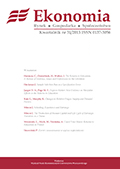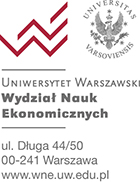Mocna efektywność informacyjna Giełdy Papierów Wartościowych S.A. w Warszawie - mit a rzeczywistość
T. Potocki, T. Świst
ABSTRAKT: The informative efficiency of the market is the issue verified considering its three different kinds. The tests of the weak form have a reflection in the prices of the shares in their historical value. The majority of the research proves that there is no possibility to achieve abnormal rate of return on the basics of technical analysis. Considering half-strong form, empirical investigation do not give one straight answer, however the majority of results leans towards supporting half-strong form of informative efficiency. Consequently, it is impossible to achieve unusual profits in a longer period of time based on the technical and fundamental analysis. The next means of the efficiency which is hard to be verified is its strong form. With regard for the need to consider this issue in the analysis of the unpublic information, it is the most difficult to examine. The aim of this article is to try to verify a strong form of the informative efficiency on the basics of assumption that recommending individuals have an access to the information which is not available to the wider group of investors. The investigation was carried out on the reports from 52 institutions, which recommendations (1925 events) concern the companies of index WIG 20 between 01.01.2005 and 03.06.2008. In most cases the results of the investigations lead towards the hypothesis that there is a strong informative efficiency in the Stock-Exchange in Warsaw.
Pełny tekst (PDF)
Numer wydania: 23
W numerze:
FDI in Poland: Determinants and Implications for Countries in Transition
C. Delaunay, A. Kocia, M. Lubienecka, R. Torrisi
ABSTRAKT |
PDF
Author This paper examines the determinants of Foreign Direct Investment (FDI) in Poland and the Polish FDI experience since economic transition to a market economy began in late 1989 and some policy implications for similar economies. Using the ARIMA regression methodology, with a one year auto regressive lag for the independent variables, the model tested the dependency of FDI in Poland to a number of macro-economic variables for the period 1991 to 2006.
This paper validates the positive linkage between market size and FDI in Poland. In addition, other factors i.e. exchange rate, corporate taxes, and accession to the European Union were found to be significant determinants. However, both the variables associated with openness to trade and rising wages were not significant determinants.
This paper suggests that macroeconomic performance, the relative strength of the US dollar and regional economic integration are important factors in attractiveness of FDI in host countries. Additionally, existing tax rates may impact FDI, but experience and data suggest that foreign investors with long term planning horizons are attracted by expected future profitability and future rate declines. From a firm's perspective, this paper suggests that the additional risks of market entry via FDI are acceptable to decision makers when the host economy is growing and committed to economic liberalization, market determined currency valuation and regional integration, while labour costs per se are not significant barriers to FDI.
The successful economic transformation and the ensuing positive experience of foreign investors in Poland provide evidence and confirmation that significant FDI opportunities may be realized in similar transition economies.
Mocna efektywność informacyjna Giełdy Papierów Wartościowych S.A. w Warszawie - mit a rzeczywistość
T. Potocki, T. Świst
ABSTRAKT |
PDF
The informative efficiency of the market is the issue verified considering its three different kinds. The tests of the weak form have a reflection in the prices of the shares in their historical value. The majority of the research proves that there is no possibility to achieve abnormal rate of return on the basics of technical analysis. Considering half-strong form, empirical investigation do not give one straight answer, however the majority of results leans towards supporting half-strong form of informative efficiency. Consequently, it is impossible to achieve unusual profits in a longer period of time based on the technical and fundamental analysis. The next means of the efficiency which is hard to be verified is its strong form. With regard for the need to consider this issue in the analysis of the unpublic information, it is the most difficult to examine. The aim of this article is to try to verify a strong form of the informative efficiency on the basics of assumption that recommending individuals have an access to the information which is not available to the wider group of investors. The investigation was carried out on the reports from 52 institutions, which recommendations (1925 events) concern the companies of index WIG 20 between 01.01.2005 and 03.06.2008. In most cases the results of the investigations lead towards the hypothesis that there is a strong informative efficiency in the Stock-Exchange in Warsaw.
Trzy wersje EVA®: zgodność z ostatecznym celem działania przedsiębiorstwa, kontrolowalność i prostota
A. Cwynar
ABSTRAKT |
PDF
Periodic performance measure should be goal-congruent: it ought to motivate managers to achieve firm's goals, including its ultimate goal, i.e. NPV maximization (owners' wealth maximization). It should also be controllable and simple. There is a measure especially promising in the field of congruity—residual income and its most popular variant, economic value added (EVA). One can distinguish three versions of EVA using three different methods of depreciation: EVA based on book depreciation (EVABV), EVA based on annuity depreciation (EVAANN) and EVA based on economic (present value) depreciation (EVAPVD). First version—EVABV—offers so called weak goal-congruence, second one—semi-strong goal-congruence and finally there is strong goal-congruence in the case of EVAPVD (with IRR as discount rate). In practice the difference in the level of congruence between EVABV and EVAANN is relatively small. They are also equally controllable because they do not include expectations concerning future performance. EVAPVD is much less controllable because of its dependency on expectations via economic (market) values. From the point of view of simplicity, EVABV is the most preferable version. EVAANN and EVAPVD are much less practical. Ultimately, it seems that EVABV can offer the most beneficial proportions of congruity, controllability and simplicity, especially if one take into account the fact that stronger congruity can be achieved by imposing a special mechanism, e.g. bonus bank.
Mieszkaniowa symulacja
M. Gorczyca
ABSTRAKT |
PDF
This article presents the simulation of the investment founds and the effects of housing construction to obtain the equalization of the amount of flats with the amount of households and to obtain the standard of 38 m2 interior usable area per capita (the average level in the European Union in about 2025). The simulation was carried out considering two different levels of average growth of the GDP (Gross Domestic Product) in the period of 2006–2025 and necessary for implementing these assumptions in the growth of housing investments.
Rola podejścia procesowego w ograniczaniu ryzyka
L. Chodorowski
ABSTRAKT |
PDF
This article describes the importance of the process management in a given institution (first of all financial institution), especially in area of the risk reduction. The correct implementation of the process approach in given institution involves to take up several performances. Firstly identification of all processes in the institution, this means building the process map. Next the institution should establish for a given process: its income and outcome, the purpose and the effect (product, service) strictly connected with it, the process sources (staff, things) and finally risks identified in the process. What’s more in article author’s opinion the every process can be described as the mathematical function. Generally speaking the established process map should facilitate to run effectively the risk management. Moreover the Key Risk Indicators (KRI), which are systematically calculated, can support the objectivity of the risk assessment in the range of the risk management. Simultaneously the risk map can be also useful in order to conduct: the cost budgeting, the internal control and internal audit activity, the implementation of new IT softwares, the analysis of effectiveness and efficiency of the organizational framework and the human resources, the analysis of internal procedures etc.
The few central banks in the Western Europe implemented a few ages ago the process maps. In the range of this maps, especially in the range of the identified processes, the levels of risk were estimated and reduced. As far as the National Bank of Poland (NBP) is concerned, this bank implemented in 2005 the unique 3-level risk management system. The NBP is permanently improving this system at present.
Rankingi konkurencyjności krajów - próba oceny
M. Bloch, T. Gajderowicz, M. Węglińska, M. Wilamowski
ABSTRAKT |
PDF
The article investigates the research of two most popular rankings of country competitiveness: The Global Competitiveness Report (published by The World Economic Forum) and The World Competitiveness Yearbook (published by The International Institute for Management Development). The difference in constructing the research was shown and the consequences of conclusions. The recommendations were introduced how to interpret rankings objectively.
Wpływ wielkości firmy na kształtowanie się procesu decyzyjnego dotyczącego lokalizacji przestrzennej przedsiębiorstwa
T. Kopczewski, P. Kusztelak, M. Pogorzelski
ABSTRAKT |
PDF
In the models of the horizontal product differentiation it is assumed that all the consumers will decide on purchase of goods, it means that there will be the full market saturation assumption. The authors of the work study the influence of overthrowing this unreal theory on the balances in one and two dimension models of location. In order to verify the balances the experiment has been carried out to study the choices of the participants regarding the location of the company according to the level of the market saturation. The experiment confirmed the influence of the size of the company on its location and demonstrated the occurrence of negative relationship among the size of the companies and the distance between them in the balanced state. The large firms chose the central location, the Principal of Minimum Product Differentiation, when the small enterprises were creating separate monopolistic markets, the Principal of Enough Product Differentiation. Decisions that were made both by large and small enterprises as and small they were correct with the theoretical expectations. Only medium enterprises were located closer to each other than the theory was assumed. The reason of this was a desire to be located in the central point of the market in order to gain the quantity leader's position. It took place by the cost of the lost of parts of profit.

